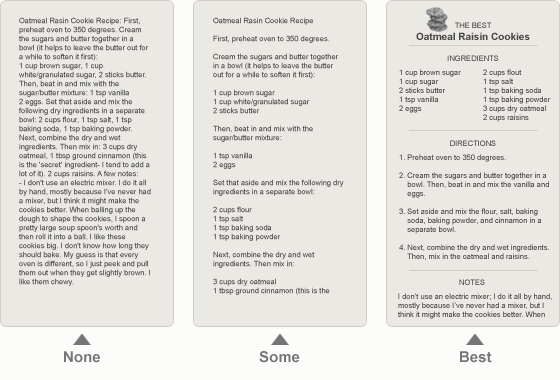Have you started to get the feeling that you’re a lone voice, crying out from the wilderness? You’ve been blogging for a few years now, but nothing seems to be coming from it. You’ve tried all kinds of ways of promoting your content, but nothing seems to work. Readers just aren’t sticking around. The truth is that no promotion method is going to make your blog a success. Sure, the right luck with social media might get you a spike in traffic, but until your content truly captures the attention of readers, no single spike will turn into lasting engagement.
Blogging has, at this point, become a central piece of the content strategy of most marketing websites. Almost two years ago, I wrote a newsletter simply asking, “Is it Time to Start a Blog?” Since then, many of our clients have answered that question in the affirmative, yet continue to struggle with blogging. Whether on the basis of incoming traffic or engagement around the content, they sense that their blog has just not lived up to their expectations.
This month, I’d like to look at the two primary reasons your blog is not living up to its potential—that you’re not writing enough, and the articles you do write are difficult to read—and recommend a few simple things you can do to correct that…
You’re Not Writing Enough
Writing isn’t easy. Even for those to whom writing comes a bit more naturally, it is still a discipline that requires regular exercise. But successful writing doesn’t have to always look the same; it can be done in a variety of ways depending upon the way in which you are best suited to engage with ideas. Finding your natural engagement style is the first step toward satisfying the discipline of writing—by doing so on a regular basis.
Talkers

*Note: This is not an actual video, just an example of what a talker might do to create blog content.
If you are a talker, you are probably most comfortable developing ideas as you speak and perhaps feel comfortable doing so with or without an audience. One simple way to capitalize on your natural engagement style would be to start recording audio or videocasts and publishing them on your blog. Doing this will still require regular practice, just like writing, but if you are naturally inclined to work out ideas by talking about them, simply recording yourself speaking may allow you to develop good content much more quickly than struggling with words on a page. Once you’ve done this enough, your recordings could also be transcribed and turned into written posts. Even if you end up only using your recordings as drafts towards writing, they will be critical to improving the regularity and quality of your articles.
Listeners

Listeners do well in dialogues, being able to bounce ideas back and forth and shape them through conversation with others. For a listener, the idea of solitary writing is probably such a challenge that any potential for working through ideas is stifled at the get-go by the presence of an empty page rather than a living, thinking partner. Like talkers, listeners might do well to start with what comes naturally—create an opportunity to have a conversation, and record it, either with video or audio. The recording itself may be good enough to post, but you could also transcribe it, giving you the opportunity to edit out the parts of the discussion that are less germane to your core topic or enhance it by linking to other content that may be referenced by you or your conversation partners. By the way, I saw a great example of this done recently by Portigal Consulting at Core77.
Visual Thinkers

Realizing that many of our agency partners are truly visual thinkers was the seed thought to this entire article. No wonder they can’t write—they force themselves to start with words rather than the images their mind has already created! When considering an idea, visual thinkers will often see a picture in their mind—one that could actually be quite complex—that is more articulate in and of itself than the words they may choose to explain it. For visual thinkers who don’t take advantage of their own innate ability to envision images, writing will be frustrating and likely less fruitful. One way to use your natural engagement style would be to begin by simply describing the images you see, then going back to sort out how those descriptions should be edited and structured best for an article. On the other hand, why not begin by actually creating those images and then writing responses to them? Storyboarding an article may be the best way for a visual thinker to get to the core of their idea and remain engaged with it long enough to complete the written portion (a portion of my “storyboard” for this article is shown in the example above). Some (if not all) of the images you create may even end up serving as helpful and engaging illustrations for readers. In fact, some readers are more likely to read your articles if they have a strong visual component—more on that later.
Good Old-Fashioned Writers

Perhaps you’re naturally inclined to engage with ideas as you write, but lack of time and abundance of distractions keep you from getting those ideas down in writing before they slip away or the moment of inspiration passes. The simplest solution to this is to keep an ideas document handy. Whether on your computer’s desktop or in a physical journal, give yourself a place to jot your ideas down when they’re fresh so that you can come back to your “idea bank” when you need to “make a withdrawal.”
If you’re interested in writing, we have a lot more information on making professional writing a priority at your firm and planning for writing, as well as a presentation on professional writing for the unprofessional writer.
Planning
No matter what your engagement style is, you’ll still need to do some planning in order to ensure that you are thoughtfully shaping your blog and actually following through with your intention to write. Create an editorial calendar, and, in addition to identifying who will write and how often you will publish, plan out the kinds of posts you will write. This could mean the various topics you’d like to cover (i.e. technique, current industry issues, general philosophy of work, or recounting specific work you’ve already done) or the formats you’d like to repeat (i.e. mini case studies, dialogues, interviews, reviews, etc.). A calendar like this should serve as an accountability tool when you encounter what every other writer in history has struggled through—boredom, indifference, confusion, or writer’s block—and a guide by which to remain on the path of regularly creating quality content.
Your Articles are Difficult to Read
True or False: “If you write it, they will read.” The answer, of course, is False! There is just too much content (and too little time) for any of us to expect that what we write will capture the attention of readers without a little extra work. In preparation for this article, I asked a question on LinkedIn to confirm what I suspected was going to be the case, that the format of an article—its length, title, how the text is layed out, and the use of images—is just as likely to determine whether people actually read it as are good ideas and quality writing.
Format for Scanability

Anything you write is competing for attention with about a billion other articles on the web. The impression your article makes on a reader in that incredibly brief moment in which she decides whether or not to stick around and read is almost completely dependent upon it’s format. Can the reader quickly scan the article and figure out whether its relevant enough to actually read? If you’ve got a title and a single block of text, probably not. That extra bit of work I mentioned above involves breaking up your article so that it is easy to scan and easy to read. Ideally, your blog should be integrated with your website and inherit its existing design and text styling, which should already satisfy the requirement of good typography for screen reading. But you’ll need to further style and arrange the content of your article, using sub-headlines, shorter paragraphs, lists, and images, to provide a visual structure to it that can be apprehended quickly so that the reader can make an informed decision as to whether to stay or go.

As a case in point, I’ve created an example above that shows the benefits of formatting text. I’m intentionally using a recipe rather than a typical web article to show that the principle of formatting enabling quick recognition is quite sound. Even at a very reduced size, the kind of information is immediately apparent in the formatted version, while not in the unformatted one. The more formatting is done to the text, the more recognizable it is.
Use Images

The majority of articles that I end up reading online have some kind of visual component. A good image can help to indicate the purpose and content of your article even more quickly than the format of the article itself, which means you should not discount the importance of pictures. But in addition to the quality of the images themselves, consistency in use can enable the kind of scanability your article needs to retain readers. Consider the illustration above, which shows how most blog authors use images—randomly, with no consideration of structure—compared with sticking to predefined “templates.” This kind of approach doesn’t require any sophisticated programming beyond the standard content area you have in your blog. It just means identifying rules in advance for the sizes and placement of images so that within a single article, or from one article to another, they’re used consistently.
Engage Readers with Contextual CTA’s

Linking to other articles, whether on your site or elsewhere, can be a helpful way to provide your readers with more information about the content of your articles. But simply linking a word in a sentence may not be the best approach. A hyperlinked word may not tell the reader enough about where she might end up or what she might see for her to feel comfortable clicking it. Be more intentional about linking to other resources by placing them in context with the content they refer to and being explicit about what they are. If you’re doing this manually (as opposed to some kind of widget that automatically chooses related content for you), use language that feels human. Repeatedly prompting links of this kind with “Related content:” feels robotic and won’t be as effective in engaging readers by making it clear to them that you’ve chosen those links personally and intentionally. For internal links, this practice can be an effective way of maintaining reader engagement on your site, which is why I tend to think of them as calls to action just as important as a sign up form.
Onward!
I hope these tips are helpful in giving you the jump start you need to improve your blog. All of them assume that what you are writing is worthwhile, quality content—otherwise, no amount of styling or arranging will bring your blog up to the next level. I also didn’t cover much in the way of engagement—a huge aspect of creating and maintaining activity around your blog—mostly because it’s been covered so much in our newsletters, blogs and webinars (most recently in our last newsletter’s section on nurturing). I’d love to know if there are additional areas that you think should have been covered here, or if you have any success by putting these suggestions into practice.

 If you’re interested in writing, we have a lot more information on making professional writing a priority at your firm and
If you’re interested in writing, we have a lot more information on making professional writing a priority at your firm and 

